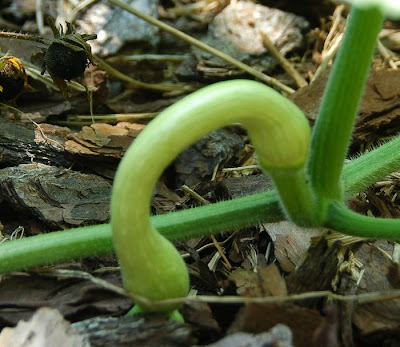 We have two farmer's markets in our immediate community now -- the one on campus is associated with the Student Organic Farm, and the other is in a small historic town nearby. Both are wonderful to have; I like to visit both, even though we don't exactly need many vegetables this time of the year. (We did a CSA share with the Student Farm for several seasons, before I realized that there was no way that the two of us could eat all those vegetables, in addition to what I was growing - and finally, the huge bunches of edamame two weeks in a row - in pods and on their stems in a giant bag, was the tipping point).
We have two farmer's markets in our immediate community now -- the one on campus is associated with the Student Organic Farm, and the other is in a small historic town nearby. Both are wonderful to have; I like to visit both, even though we don't exactly need many vegetables this time of the year. (We did a CSA share with the Student Farm for several seasons, before I realized that there was no way that the two of us could eat all those vegetables, in addition to what I was growing - and finally, the huge bunches of edamame two weeks in a row - in pods and on their stems in a giant bag, was the tipping point).And, they're really nice students, but they don't always know that the secret to delectable vegetables is to harvest them at the perfect time -- when they're young and tender, not when they're big, especially with squash and beans.
But free-range eggs (from our university's flock), fresh melons, peaches, and whatever else might be offered are reason enough to visit and support both markets.
 Today, I bought fresh figs (I really want to have a fig tree) and some delicious red-fleshed plums from an older couple, and then bought a small loaf of bread from a bread-baker who grinds her own flour. I definitely don't need to buy bread (being a keen bread-baker myself), but the idea is so appealing to me that she's baking bread and cookies from flour that she's freshly ground (even if the wheat kernels come from Montana) that I can't resist.
Today, I bought fresh figs (I really want to have a fig tree) and some delicious red-fleshed plums from an older couple, and then bought a small loaf of bread from a bread-baker who grinds her own flour. I definitely don't need to buy bread (being a keen bread-baker myself), but the idea is so appealing to me that she's baking bread and cookies from flour that she's freshly ground (even if the wheat kernels come from Montana) that I can't resist.As a child, visiting my paternal grandparents in Northern California, I was fascinated by the navel orange tree that grew over the fence. My maternal grandmother had a pantry full of canned vegetables and preserves, and had a large vegetable garden and berry patch that was well-tended and productive. The produce markets in the East Bay area (across from San Francisco) were already thriving three decades ago; as a graduate student, I discovered a bounty of diverse peppers, fresh mushrooms, brussels sprouts, and fresh carrots (my mom, not an avid cook, relied on frozen vegetables, as did many of her 'modern' generation). The summer fruits that California produces in abundance were also available, fresher than any that were shipped.
And visiting markets in Europe, Asia, and South America and seeing the diversity of things that we can grow has only encouraged my interest in what I can grow (and what people in my community can grow) and the vital connection that we have with soil, habitat, and the plants and natural communities that sustain us.









































.jpg)





